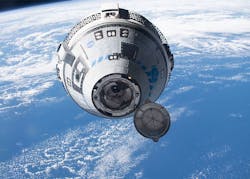Boeing chooses DDC to provide 1553 avionics databus components for CST-100 Starliner manned spacecraft
BOHEMIA, N.Y. – Spacecraft designers at the Boeing Co. needed MIL-STD-1553 avionics databus networking components for their CST-100 Starliner space capsule. They found their solution from Data Device Corp. (DDC) in Bohemia, N.Y.
Designers at the Boeing Defense, Space & Security segment in St. Louis chose DDC MIL-STD-1553 data bus components for the CST-100, which has completed a docking maneuver with the International Space Station (ISS) as part of an uncrewed orbital test flight.
DDC's 1553 transceivers and transformers are designed into the Starliner's Crew Module-Integrated Propulsion Controller (CM-IPC) and the Service Module-Integrated Propulsion Controller (SM-IPC) of the spacecraft.
Boeing chose DDC for these systems because of DDC's reliability, performance and ruggedness of our data bus solutions. company officials say.
DDC's MIL-STD-1553 application-specific integrated circuits (ASICs_ have achieved over 1 billion hours of in-service history on aerospace, defense, and space applications.
"With more than 25 years of experience as a leading supplier of radiation hardened MIL-STD-1553 data bus components, DDC is dedicated to the innovation and advancement of data bus technology for space," stated Brian Forsberg, DDC's business unit manager for data bus components.
The Boeing CST-100 Starliner consists of two partially reusable spacecraft -- a crew capsule and expendable service module -- to transport crew to the International Space Station (ISS) and other low-Earth-orbit destinations.
The capsule is slightly larger than the Apollo command module and SpaceX Dragon 2, and smaller than the Orion capsule. The Boeing Starliner holds a crew of as many as seven people and can dock to ISS for as long as seven months. Experts say the spacecraft can be reused as many as 10 times.
It launch aboard the Atlas V, Delta IV, Falcon 9, and Vulcan Centaur rockets. NASA chose the Boeing Starliner and SpaceX Crew Dragon rocket for the Commercial Crew Transportation Capability (CCtCap) contract.
In late 2019, the uncrewed Boeing Starliner Orbital Flight Test launched on a Atlas V N22 and reached orbit, but the flight failed to meet all of its test goals. An unmanned test launched in May 2022, and the first crewed launch is scheduled for later this year.
For more information contact DDC online at www.ddc-web.com, or Boeing Defense, Space & Security at www.boeing.com/space/starliner.
About the Author
John Keller
Editor-in-Chief
John Keller is the Editor-in-Chief, Military & Aerospace Electronics Magazine--provides extensive coverage and analysis of enabling electronics and optoelectronic technologies in military, space and commercial aviation applications. John has been a member of the Military & Aerospace Electronics staff since 1989 and chief editor since 1995.
